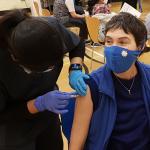“This is no time to stop tracking COVID-19.
COVID-19 trends
A Two-Month Cycle Experts Can’t Explain
A mysterious pattern suggests that the U.S. Delta wave could be starting to ebb.
The media took an optimistic assessment of the current situation, but new cases remain far worse than when the pandemic began in March of 2020 or at the subsequent low point in June.








